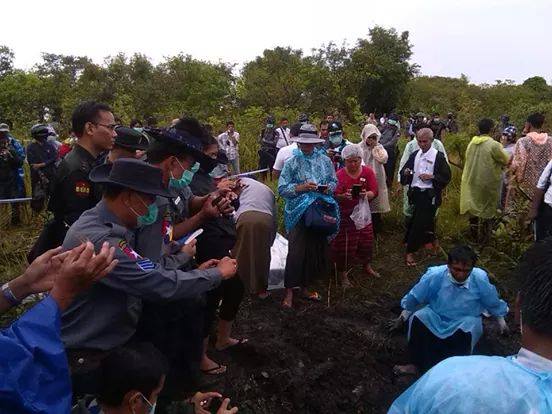Five bullet wounds were uncovered on the exhumed body of Par Gyi, according to a doctor involved in his autopsy, speaking to Naw Ohn Hla, the head of the Democracy and Peace Women Network and a colleague of Ma Thandar, Par Gyi’s widow.
“The doctor said one bullet passed through the chin to the head; two were shot through his back and exited through the chest; one was in his thigh; and one in his ankle,” she told DVB on Thursday. “He told us that the gunshot through the back had broken Par Gyi’s ribs.”
No official forensic report has yet been issued.
Journalist Par Gyi’s body was exhumed from a shallow grave in a field in Kyaikmayaw Township in Mon State on Wednesday. It was taken to Moulmein Hospital for examination.
[related]
According to eye-witness Nay Myo Zin, the corpse showed signs of a broken jaw, a caved-in skull, and swelling on the torso indicating broken ribs.
“It is completely clear that Ko Par Gyi was tortured,” he said.
Ma Thandar confirmed that the decomposed body was that of her husband.
Burmese military officials maintain that Par Gyi was shot dead as he attempted to wrest control of a gun from a guard and then tried to run away.
More than 100 people witnessed the exhumation, including activists and members of civil society groups. Many slammed the conditions under which the slain Burmese journalist was buried.
Mee Mee of the 88 Generation Peace and Open Society said, “The body was not buried deep. It was about six inches below the surface. It is not true what the government said about the body being buried properly.”
Activist Naw Ohn Hla said, “I feel sorry that the government statement was not true. There was not even a mat placed under the body. It was the worst abuse of human rights I have ever seen. This citizen was treated brutally. I feel very bad about it.”
Meanwhile, eight Buddhist monks have tried to intervene to prevent Par Gyi’s remains from being transported back to Rangoon for burial.
According to Ma Thandar: “They said they wouldn’t allow me to take the body. Mon culture doesn’t allow the transfer of a dead body from one area to another.”
Naw Ohn Hla suggested the monks had ulterior motives.
“We asked them [the monks] where they were from, but they wouldn’t tell us,” she said. “They refused to say which monasteries they were from. We could also smell alcohol on their breaths.”
Nai Layitama, a member of Mon National Party’s central committee, said the eight monks were not Mon.
“These monks said that their instructions [not to transport the body] were based on Mon culture,” he told DVB. “But they are not even Mon monks. They didn’t even know how to speak the Mon language.”
Par Gyi’s widow, Ma Thandar, said she just wants to take her husband’s body to his hometown for a proper burial.
“I am a widow trying to get justice,” she told reporters. “I think all people—anyone with a family—would sympathize with me. I just want to be allowed to bury my husband’s body. I want to request permission from the authorities to do this.”



